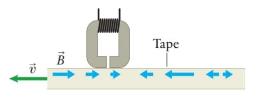Analog tape players read sound recorded on magnetic tape. The sound is recorded by magnetizing the tape
Question:
Analog tape players read sound recorded on magnetic tape. The sound is recorded by magnetizing the tape longitudinally (magnetization parallel to the tape's length) with varying magnetic field magnitudes in either direction. The tape is usually divided into longitudinal tracks so that different signals can be recorded in parallel. In the player, as the tape is pulled across the reading head, a varying emf is induced in a coil wound around the C-shaped metal core of the head (Figure P29.77). This emf is then amplified and sent to the speakers. Trying to learn more about the physics of this technology, you read that the recorded signal magnitude is usually given in terms of fluxivity, which is the peak magnetic flux per track width. In particular, you find a paper that gives a fluxivity of \(320 \mathrm{nWb} / \mathrm{m}\) for a \(1000-\mathrm{Hz}\) sine wave recorded on a track \(6.3 \mathrm{~mm}\) wide [O. Schmidbauer, J. Audio Eng. Soc., 46(10), 859 (1998)]. Naturally, not all of the flux generated threads through the coil, but your search shows that reading heads can have a "flux efficiency" of \(98 \%\) [J. G. McKnight, B. E. Cortez, and J. A. McKnight, J. Audio Eng. Soc., 46(10), 845 (1998)] and that 250 coil windings are typical. You begin to wonder about the emf induced in the coil and how the frequency of the recorded sound relates to the speed \(v\) with which the tape runs.
Data from Figure P29.77

Step by Step Answer:






